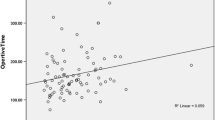Abstract
Background
Symptoms of gastroesophageal reflux disease (GERD) are experienced by up to 85% of pregnant women. Some young women on maintenance proton pump inhibitor (PPI) treatment are choosing surgery to stop their medical treatment and avoid severe symptoms during pregnancy. There are no reports describing the effect of pregnancy on the long-term efficacy of laparoscopic Nissen fundoplication. The aim of this study was to evaluate the effect of pregnancy on the efficacy of laparoscopic Nissen fundoplication.
Methods
This study surveyed 146 women of childbearing age with proven GERD who had undergone laparoscopic Nissen fundoplication from 1992 through 2002. The patients who became pregnant (group 1) were compared with those who did not (group 2).
Results
The study focused on 25 patients who became pregnant after surgery. Of these patients, 40% (n = 10) had chosen surgery as a way to discontinue PPI treatment before pregnancy. The mean time from laparoscopic Nissen fundoplication to pregnancy was 25.9 ± 4.6 months. A total of 19 patients (76%) had no reflux symptoms, whereas 5 (20%) required antacids during pregnancy. One patient (4%) experienced an acute intrathoracic stomach migration during her pregnancy and required emergency open surgery, which resulted in the loss of her fetus. After pregnancy, six patients (24%) had recurrence of GERD symptoms, and three (12%) required a redo fundoplication. The higher rate of GERD recurrence (24% vs 16.7%) and redo surgery (12% vs 4%) in group 1 did not reach statistical significance, but showed a definite trend.
Conclusion
For most patients, laparoscopic Nissen fundoplication is effective in controlling GERD symptoms during and after pregnancy.

Similar content being viewed by others
References
Al-Amri SM (2002) Twenty-four hour pH monitoring during pregnancy and at postpartum: a preliminary study. Eur J Obstet Gynecol Reprod Biol 102: 127–130
Allen CJ, Parameswaram K, Belda J, Anvari M (2000) Reproducibility, validity, and responsiveness of a disease-specific symptom questionnaire for gastroesophageal reflux disease. Dis Esophagus 13: 265–270
Anton CR, Anton E, Stanciu C (2001) Gastroesophageal reflux disease in pregnancy. Rev Med-Chirurg Soc Med Si Naturalisti Din Lasi 105: 43–47
Anvari M, Allen CJ (1998) Laparoscopic Nissen fundplication: two-year comprehensive follow-up of a technique of minimal paraesophageal dissection. Ann Surg 227: 25–32
Anvari M, Allen CJ (2003) Five-year comprehensive outcomes evaluation in 181 patients after laparoscopic Nissen fundoplication. J Am Coll Surg 196: 51–57, discussion 57–58, author reply 58–59
Anvari M, Allen CJ, Borm A (1995) Laparscopic Nissen fundoplication is a satisfactory alternative to long-term omeprazole. Br J Surg 82: 938–942
Broussard CN, Richter JE (1998) Treating gastroesophageal reflux disease during pregnancy and lactation: what are the safest therapy options? Drug Safety 19: 325–337
Campos GM, Peters JH, DeMeester TR, Oberg S, Crookes PF, Tan S, DeMeester SR, Hagen JA, Bremner CG (1999) Multivariate analysis of factors predicting outcome after laparoscopic Nissen fundoplication. J Gastrointest Surg 3: 292–300
De Meester TR, Bonavina L, Albertucci M (1986) Nissen fundoplication for gastroesophageal reflux disease: evaluation of primary repair in 100 consecutive patients. Ann Surg 204: 9–20
Gonzalez R, Bower SP, Swafford V, Smith CD (2004) Pregnancy and delivery after antireflux surgery. Am J Surg 188: 34–38
Grande L, Toledo-Pimentel V, Manterola C, Lacima G, Ros E, Garcia-Valdecasas JC, Fuster J, Visa J, Pera C (1994) Value of Nissen fundoplication in patients with gastroesophageal reflux judged by long-term symptom control. Br J Surg 81: 548–550
Hartsilver EL, Vanner RG, Bewley J, Clayton T (1999) Gastric pressure during emergency caesarean section under general anaesthesia. BJA 82: 752–754
Hunter JG, Swanstrom L, Waring JP (1996) Dysphagia after laparoscopic antireflux surgery: the impact of operative technique. Ann Surg 224: 51–57
Hunter JG, Trus TL, Branum GD, Waring JP, Wood WC (1996) A physiologic approach to laparoscopic fundoplication for gastresophageal reflux disease. Ann Surg 223: 673–687
Jamieson GG, Duranceau AC, Deschamps C (1988) Surgical treatment of gastroesophageal reflux disease. In: Jamieson GG, Duranceau AC (eds) Gastroesophageal reflux. WB Saunders, Philadelphia, PA pp 10–35
O’Boyle CJ, Heer K, Smith A, Sedman PC, Brough WA, Royston CM (2000) Iatrogenic thoracic migration of the stomach complicating laparoscopic Nissen fundoplication. Surg Endosc 14: 540–542
Peracchia A, Bancewicz J, Bonavina L, DeMeester T, Hennessy T, Launois B, Lundel L, Peters J, Siewert R (1995) Fundoplication is an effective treatment for gastroesophageal reflux disease. Gastroenterol Int 8: 1–7
Richter JE, (2003) Gastresophageal reflux disease during pregnancy. Gastroenterol Clin North Am 32: 235–261
Wu JS, Dunnegan DL, Luttmann DR, Soper NJ (1996) The influence of surgical technique on clinical outcome of laparoscopic Nissen fundoplication. Surg Endosc 10: 1164–1170
Acknowledgments
The authors acknowledge Leslie DiLuca and the Motility Laboratory technicians for assistance in data collection, and Catherine Gill Pottruff and Paula McKay for assistance in data collection, statistical support, and assistance in preparation of the manuscript.
Author information
Authors and Affiliations
Corresponding author
Rights and permissions
About this article
Cite this article
Biertho, L., Sebajang, H., Bamehriz, F. et al. Effect of pregnancy on effectiveness of laparoscopic Nissen fundoplication. Surg Endosc 20, 385–388 (2006). https://doi.org/10.1007/s00464-005-0225-3
Received:
Accepted:
Published:
Issue Date:
DOI: https://doi.org/10.1007/s00464-005-0225-3




